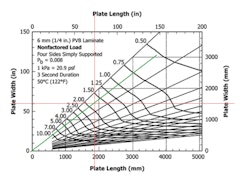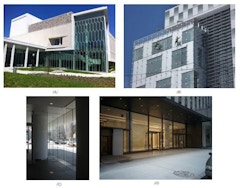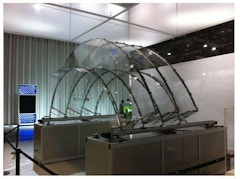169 results
-
Embodied carbon in buildings is a key factor in building decarbonization and while it is generally small compared to operational carbon, the…
-

Glass Spandrels and Shadow Boxes
- Paper by John Jackson,
Glass spandrels are a common design strategy utilized to opacify floor levels in building facades. These opaque glass assemblies are integrated into… -
Glass Balustrade Design
- Paper by Richard Green, PE, SE, P.Eng, CPEng IntPE(Aust), APEC Engineer · Andrew Crosby, PEng · Terrence McDonnell S.E., P.E., P.Eng., SECB
Glass handrail design in the United States lags behind best practice in other parts of the world. There can be as much as a factor of four (4)
-
Glass Strength Under Point Loading
- Paper by Joshua Schultz, Ph.D, P.E., LEED AP, ENV SP · John Knowles, PE SE · Kedar Malusare
Structural glass is used in a range of building applications, and while the ASTM E1300 has recently been updated to provide a design method to
-

Glass and Electromagnetic Eavesdropping Protection
- Paper by Eric Stein,
Glass is a key component in building design. Benefits of utilizing Insulating Glass Units (IGUs) within a building facade are well understood,… -

Undulated Glass Self-shading
- Paper by Nebojsa Jakica · Mikkel K. Kragh
The research is structured around complex optical effects of undulated glass and coatings that exhibit high reflectivity, especially at higher
-

The Glass Failure Prediction Model
- Paper by James G. Soules, P.E., S.E., P.Eng., SECB, F. SEI, F. ASCE, Graduate Student, Department of Civil, Environmental, and Construction Engineering Stephen M. Morse, P.E., Ph.D., A.M, ASTM, Assistant Professor of Civil and Environmental Engineering H. Scott Norville, P.E., Ph.D., F. FTI, F. ASCE, F. ASTM, Professor, Department of Civil, Environmental, and Construction Engineering
ASTM E 1300 Standard Practice for Determining Load Resistance (LR) of Glass in Buildings defines the load resistance of a glass construction as being… -

Spandrel Glass Design
- Paper by Scott H. Norville, P.E., Ph.D. · Christopher Barry, PE · Stephen M. Morse, P.E., Ph.D. M. FTI, M. ASCE
Currently, most spandrel glass in commercial curtain walls comprises insulating glass fabricated using an interior heat strengthened glass lite that
-
Contextualizing Glass and Carbon Impacts
- Paper by Kayla Natividad, PhD, WELL AP, LEED Green Associate, Architectural Technical Service Engineer Kyle Sword, Manager Business Development
Climate change goals will require significant improvements in the way buildings are constructed and operated. Building reuse can combat climate… -

All-Glass Bearing Facades
- Paper by Erwin ten Brincke, MSc
The Green Village at the TU Delft is a living lab for sustainable innovations. The Co Creation Centre (CCC) will be their new meeting center (13.5 x… -
Insulating Glass Unit Gas Loss
- Paper by Mark K. Schmidt, M.Eng., S.E., Principal and Unit Manager Stephen M. Morse, PhD, P.E., Assistant Professor
Concerns over time-dependent argon permeation through the perimeter edge seals of insulating glass units (IGUs) led the authors to utilize two… -
Consistency In Glass Design
- Paper by Joshua Schultz, PhD, PE, LEED AP · Grace Dojan
Glass structural elements have become increasingly common to the point of ubiquity; however, there currently is no universally recognized and
-
A Structural Glass Design Manual
- Paper by Richard Green PE SE P.Eng CPEng IntPE(Aust) APEC Engineer, Principal / Owner Terrence McDonnell S.E., P.E., P.Eng., SECB, Principal Andrew Crosby BASc, P.Eng., LEED® AP BD+C, Principal
Other than limited special cases, there is a lack of standards providing guidance on the design of structural glass. This has resulted in an ad-hoc… -

Heat-Treated Glass
- Paper by Reece Poth, Conner Claus,
What was once an accepted reality in heat-treated exterior glass, optical disturbances in glass are under increasing scrutiny by developers,… -

Control Tower Glass Design
- Paper by Daniel McCormick, P.E., PMP, M.ASCE, Federal Aviation Administration Stephen M. Morse, Ph.D., P.E., M.ASCE, Assistant Professor Scott H. Norville, Ph.D., P.E., F.FTI, F.ASTM, F.ASCE, Professor
ASTM published the first version of ASTM E2461-05: Standard Practice for Determining the Thickness of Glass in Airport Traffic Control Tower Cabs in… -

Fully Tempered Glass in Spandrel Applications
- Paper by Stéphane Hoffman, PE, Lawrence D. Carbary,
Recent years have seen an increase in the use of insulated glazing units (IGUs) in spandrel applications to visually blend the appearance between the… -

Innovations with Glass
- Paper by Jens Schneider · S. Müller-Braun · T. Peters · M. Schuster
Glass has become a popular building material that is used not only for windows but also as a load-bearing material. New dimensions of glass panes in
-

Specifying Electrochromic Glass
- Paper by Belinda Valenti, AIA, LEED AP BD+C, Associate Justin Glover, AIA, LEED AP BD+C, Associate Principal
Electrochromic (EC) glass is a seemingly magical solution to a building’s sun shading problems. A technology that was originally developed about… -

Silicone Spandrel Glass Opacifiers
- Paper by Scott Norville, Samir Blanchet, George Torok, Kris Vockler, John Swanson, Chris Barry, Lawrence Carbary, Stephane Hoffman, Timothy Krytenberg, Chris Fronsoe,
Curtain wall design commonly uses insulating glass units for vision and spandrel glazing to provide better visual harmonization of building facade… -
Let Thin Glass in the Facade Move
- Paper by Prof. DI Dr. Jürgen Neugebauer · DI Dr. Markus Wallner-Novak
Facades play an important role in the control of energy flow and energy consumption in buildings as they represent the interface between the outdoor

